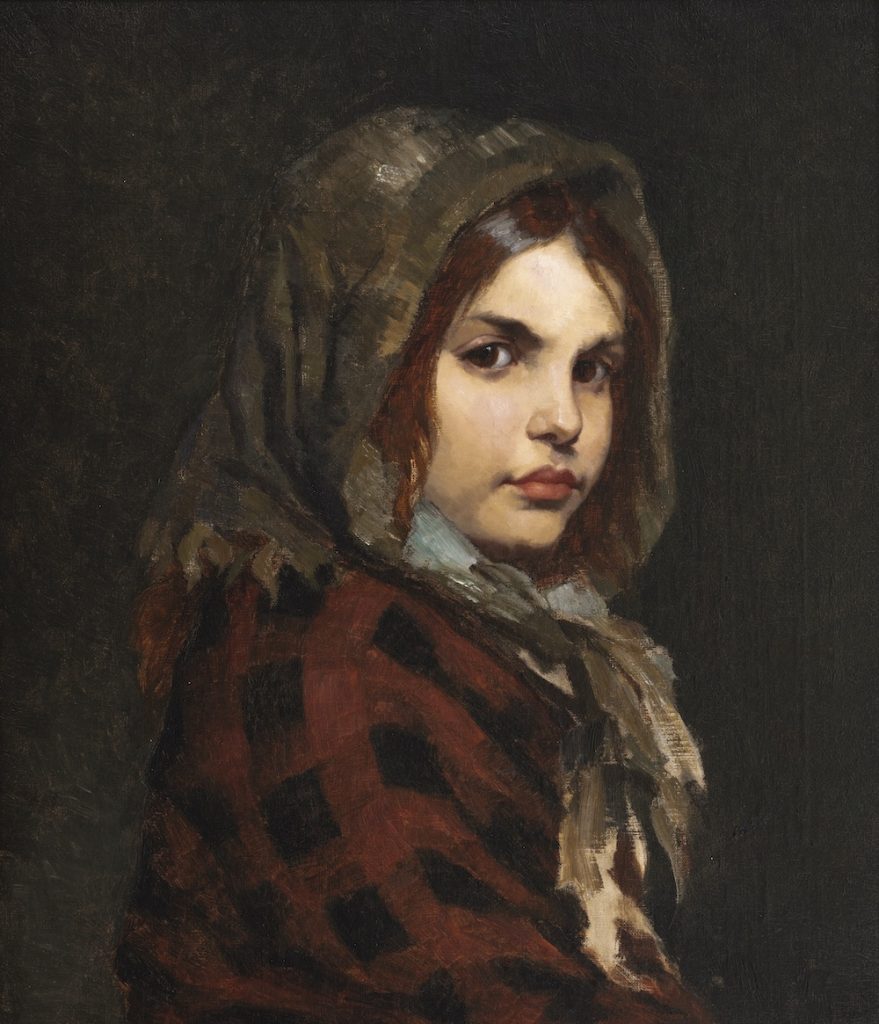Maria Wiik, Marietta
JULY 2022
Depicted from side profile, a young dark-haired girl has turned her scarf-covered head toward the viewer at whom her dark eyes cast a serious look. Rendered realistically, the light-coloured girl’s face emerges clearly from the dark backdrop with her dark clothing which creates intensity in the painting and emphasises her determined gaze.
The painting named Marietta (1880) has been painted by Maria Wiik (1853–1928), one of the most prominent female painters of Finland’s Golden Age of art. The work it is a sketch for her eponymous breakthrough panting with which she made her debut at the Salon in Paris in 1880. Thus, the work offers a splendid view on Wiik’s early career as an artist as well as on the moment when the young artist took a leap toward becoming an independent artist. Marietta was apparently a very important motif for the artist herself because she painted two very similar looking finished versions of the work.
The period when the works named Marietta were created was an exciting time for Maria Wiik. A few years earlier Wiik and her sister had travelled to Paris, the centre of art and culture, to complement the art education received in Finland. Together with a couple of her artist friends Wiik rented a studio in Paris. The purpose was to concentrate on painting independent artworks alongside studying. In her studio, Wiik had a young Italian girl who sat for her and whom the artist captured so serious looking in her Marietta paintings.
By working in her studio, Wiik aimed to get her paintings accepted for the exhibition at the Salon in Paris. In 1880s, the Salon remained an influential leader in the field of academic art. So, having one’s works accepted for the exhibition for the first time meant a transition from an art student to a professional artist. Thus, Maria Wiik must have been overwhelmed of joy when Marietta and one other of her works were accepted for the Salon in spring of 1880.
However, Maria Wiik did not make her real breakthrough until the autumn of 1880 in Finland when the in the Salon exhibited Marietta and a few other works by Wiik were put on show in the Finnish Art Society’s exhibition. Wiik’s art had been exhibited in Finland already before, but after the exhibition held in 1880, people started to more and more regard as a full-fledged artist also in her homeland.
The critics were impressed by Marietta’s sombre figure and soulfulness, and Wiik was considered talented and technically sound artist. In her homeland, Wiik’s reputation as an elaborate portrait painter spread further during the next years when she painted numerous portrait and character paintings. Even today she is remembered especially for her child portraits. The artist was particularly interested in her models’ mentality, and she was a virtuosa in depicting the character and feelings of her models in a realistic and elegant way, which is already eminent in her early Marietta paintings.
Even though the painting Marietta acquired for the Serlachius Museums’ Collection is not the work with which Wiik made her debut at the Salon in Paris and presented herself at the exhibition of Art Society, it has, all the same, been painted in equally self-assured brushstrokes and can be regarded an independent artwork in every way. The debut work ended up in a private collection, whereas the artist apparently kept this painting in her possession for a long time. It was, after all, a beautiful reminder of the early stages of her artist career.
Henna-Rosa Laine
Curator
Sources
Katerma, Pia, 1954. Maria Wiik. Werner Söderström Osakeyhtiö, Porvoo.
Konttinen, R. 2014. Taiteilijatoveruutta. Helene Schjerfbeck, Ada Thilén, Helena Westermarck ja Maria Wiik. Siltala, Helsinki.
Konttinen, R. 2000. Maria Wiik. Otava, Keuruu.
Valkonen, T. 2005. Suomalaiset maalarit Pariisissa. Uudistettu laitos. Tammi, Hämeenlinna.
Westermarck, H. 1937. Tre konstnärinnor. Fanny Churberg, Maria Wiik och Sigrid af Forselles. Söderström & C:o. Helsinki.
Nordan, 1.1.1920 Provnummer, s. 15-16.


